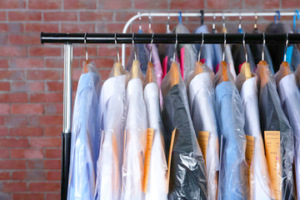 When attempting to wash certain fabrics, it is of crucial importance to check the care labels and the specific cleaning requirements mentioned there. This will ensure the best result and no damage.
When attempting to wash certain fabrics, it is of crucial importance to check the care labels and the specific cleaning requirements mentioned there. This will ensure the best result and no damage.
Some fabrics are labelled ‘’dry cleaning only’’. If you see that sign, do not ever wet or attempt to wash the garments on your own. Those fabrics cannot withstand laundry machines or dryers, therefore, a professional dry cleaner should take care of them.
If you regularly use this service, you probably wondered what the whole process really is.
We will talk about the history of dry cleaning, the methods used nowadays, as well as the whole process from the beginning to the end.
The history of dry cleaning
In fact, dry cleaning has been around since Roman times. People used ammonia to clean the woollen togas without causing shrinking which usually occurs when wool and hot water meet. Later in time, kerosene and gasoline were used, however, those petroleum-based solvents were extremely dangerous and highly flammable.
By the 1930s, cleaners were utilising perchloroethylene, also known as “perc.” This chlorinated solvent is quite effective, and many commercial cleaners still use it today. Perc has a distinct chemical odour and is believed to cause cancer in people.
Since the 1990s many health and environmental agencies have been encouraging dry cleaners to use safer and healthier alternatives as cleaning solutions.
The dry-cleaning process
Commercial dry cleaning is now safer than it has ever been. Dry cleaning isn’t better or worse than washing your clothes, but it depends on the fabric and whether the garment needs dry cleaning to keep its look and shape. It all starts when you drop off your soiled clothes at your local dry cleaners. Most dry cleaners today do not have vast and expensive cleaning equipment on-site; instead, they will transfer your laundry to a central cleaning facility. This is less expensive than having machines at each drop-off point. Each object requires numerous steps to be cleaned:
- Tagging of the garment – Clothes soiled in similar ways will be cleaned together. The tags will also help the dry cleaners identify the garments and return them back to you. While some companies use stapled or pinned paper tags and labels, others may use an iron-on strip with a special code for regular customers.
- Inspection – Before beginning the cleaning process, the professionals will inspect the clothes for rips, holes, missing buttons, and items left in the pockets. Any issues are noted before the actual cleaning, and all items are returned back to the customers.
- Stain treatment – Checking for stains is a part of the inspection. All spots will be pre-treated accordingly. It is very important that you identify the stain to the cleaner upon arrival. That way, they will know exactly how to approach it in the best way possible.
- Cleaning the clothes – Soiled clothes are placed into a big drum machine and cleaned with a chemical solvent that does not require water. The solution gently agitates the garments, causing soils to loosen. The solvent is then drained, filtered, and recycled, and the clothing is “rinsed” in a new solvent solution to remove any remaining soil.
- Post-cleaning check – Because of the chemical solvent, the dry cleaning procedure works particularly effectively in removing oil-based stains. Other forms of stains, on the other hand, are not always effectively eliminated. As a result, all clothing is checked for any lingering stains. To eliminate any remaining traces, the stains are cleaned with steam, water, or even a vacuum cleaner.
- Final steps – The final stage is to prepare the garment to wear. This includes ironing or steaming wrinkles out, reattaching buttons, and making repairs. The items are then hung or folded before being returned to the customer. The plastic bags offered are to assist you in getting your garments home without further stains.
There are a few things you should mention to your dry cleaning professional when dropping clothes off.
- Make sure your clothing labels are still on the garments. If you are used to removing the labels from your clothes, keep the ones that go to the dry cleaner. The professionals will read them and benefit from the requirements mentioned there.
- Do not attempt any stain removal at home. If you did, tell your dry cleaner exactly what you used. There might be unwanted reactions between different products, and avoiding them is best.
- Point out any stains and damage. If you know what caused the stain on your shirt, tell your dry cleaner. That will help them approach the issue in the most effective way possible. If you have missing buttons, rips, or other damage to your clothes, don’t forget to let them know as well.
Green dry cleaning
If you are interested in eco-friendly options, you can turn to a green dry cleaning company. There are a few methods that will clean your clothes without actually washing them and without including any dangerous chemicals.
- Cleaning with liquid carbon dioxide: Liquid and gas forms of carbon dioxide are used as non-toxic solvents in complex (and expensive) cleaning machines that employ pressure to draw carbon dioxide through fabrics to remove grime. Because there is no heat involved, the method is also gentler on materials.
- Silicon-based solvent: Also known as siloxane, this solvent is chemical-free liquid sand that dissolves stains from fabrics. However, because chlorine is used in the manufacturing process, the result may not be as environmentally friendly.
